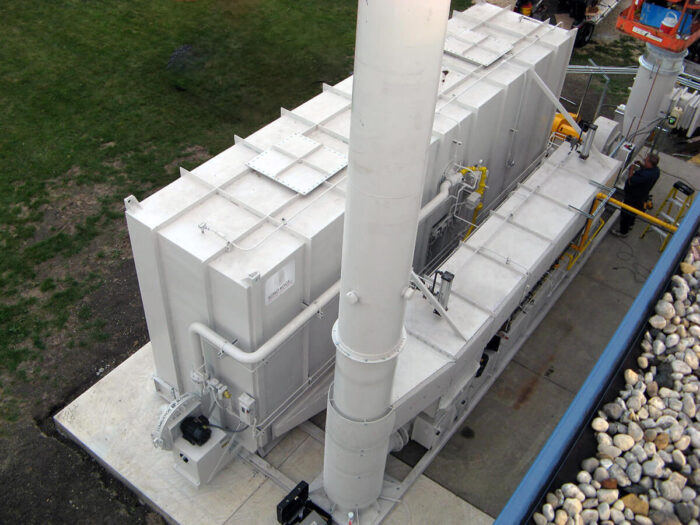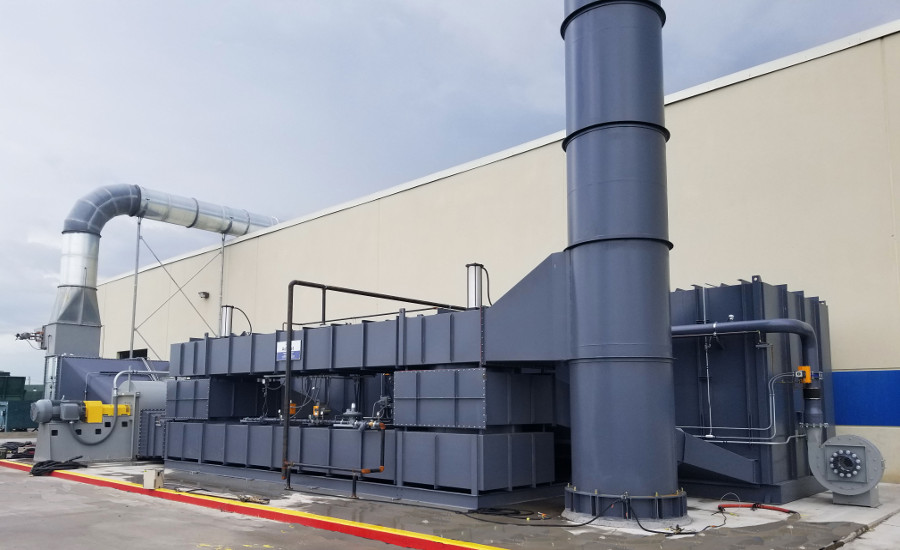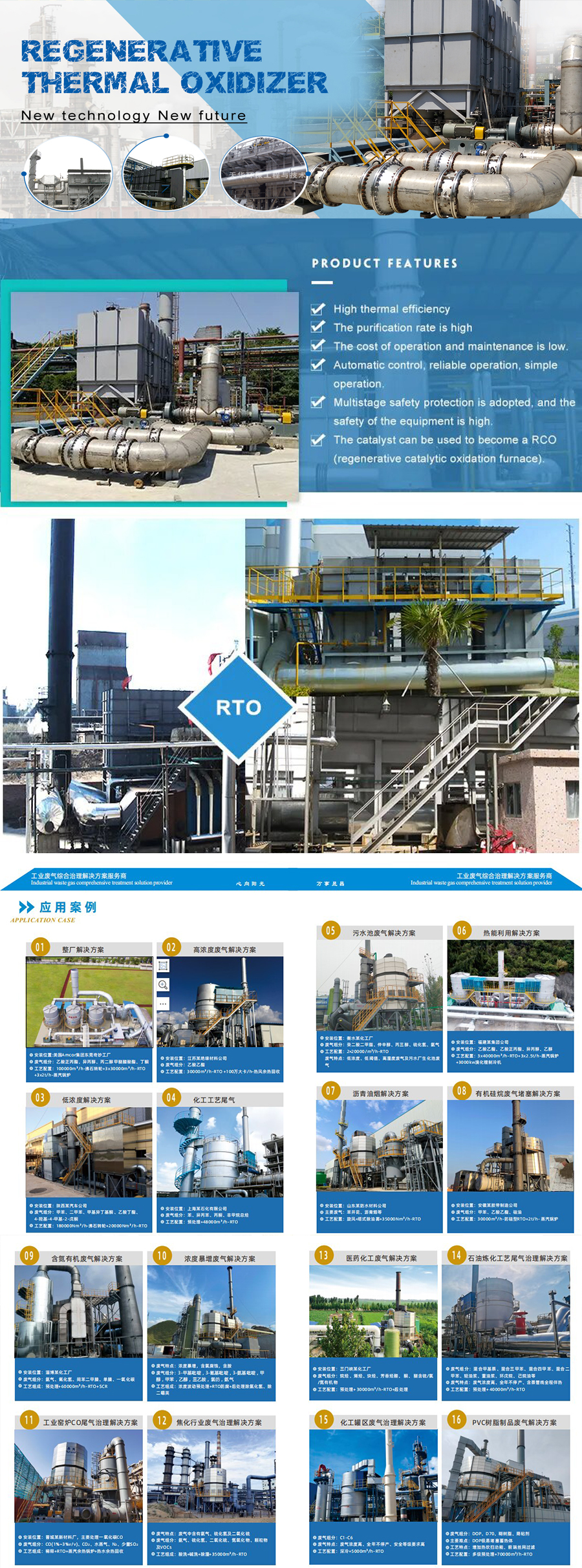Základní informace.
Model NO.
RTO
Typ
Nástroj pro monitorování životního prostředí
Hlavní funkce
Odstraňování odpadních plynů
Aplikace
Chemický průmysl
Značka
Raidsant
Čistá účinnost
99.8%
Stav
Nový
Ochranná známka
Raidsant
Přepravní balíček
Film zabalený
Původ
Zhejiang Čína
Popis produktu
HangZhou Raidsant Machinery Co.;,; Ltd.; se specializuje na vývoj a výrobu inovativních práškových chladicích peletizačních strojů a souvisejících průmyslových strojů na zpracování odpadních plynů.; S téměř 20letou historií výroby; máme dobrý trh ve více než 20 provinciích v Číně; a některé z našich výrobků byly vyváženy do Saúdské Arábie, Singapuru, Mexika,; Brazílie,;Španělsko,; Amerika,; Rusko a Korea; atd.;
Specifikace:;
* Kompaktnější než stávající zařízení
* Nízké provozní náklady
* Dlouhá životnost zařízení
* Žádné změny tlaku
Účel:;
Energeticky úsporný systém, který spaluje těkavé organické sloučeniny (VOC); a odpadní plyn využitím tepla; a shromažďuje přes 99.;8 % odpadního tepla výfukových plynů pomocí keramických regeneračních materiálů (katalyzátor); s velkým povrchem a nízkou tlakovou ztrátou.;
Aplikace:;
1.; Proces sušení malby
2.; proces tisku kovů
3.; proces sušení vláken
4.; proces lepicí pásky
5.; proces zpracování odpadu
6.; proces výroby polovodičů
7.; kouř,; cukrářský a pečicí proces
8.; petrochemický proces;
9.; proces výroby léků a potravin;
10.; jiný proces generování VOC
Zásluhy:;
* Kompaktnější než stávající zařízení
* Žádné změny tlaku
* Vysoká míra rekuperace tepla (přes 95 %);
* Perfektní VOC úprava (přes 99.;8%);
* Dlouhá životnost zařízení
* Nízké provozní náklady
* Lze vyrobit v kruhu nebo čtyřúhelníku
Obecné popisy a vlastnosti:;
1.; Princip fungování
Provozní metoda, která neustále mění výboje otáčením rotačního ventilu
2.; Změna procesního tlaku
Žádná změna tlaku, protože směr větru se mění v pořadí rotací rotačního ventilu
3.; Investiční náklady
Přibližně 70 % typu postelí
4.; Instalační prostor
Jedná se o jednu nádobu, takže je kompaktní a vyžaduje méně instalačního prostoru.;
5.; Údržba
Je snadné jej udržovat, protože rotační ventil je jedinou pohyblivou částí.;
Těsnicí část rotačního ventilu je zřídka opotřebovaná, protože se otáčí nízkou rychlostí.;
6.; Stabilita
Žádná rizika v procesu, protože je vždy otevřen, i když má rotační ventil problémy.;
7.; Účinnost léčby
Účinnost ošetření zůstává zachována, protože těsnicí část je zřídka opotřebována, i když je provozována po dlouhou dobu.;
Adresa: No.3, Zhenxin Middle Road, Zóna ekonomického rozvoje, HangZhou, ZheJiang
Typ podnikání: Výrobce/Továrna, Obchodní společnost
Rozsah podnikání: chemikálie, elektrika a elektronika, výrobní a zpracovatelské stroje, bezpečnost a ochrana
Certifikace systému managementu: ISO 9001
Hlavní produkty: peletizátor, vločkovač, pastilátor, granulátor, chemický peletizátor, voc
Představení společnosti: HangZhou Raidsant Machinery Co., Ltd., dříve nazývaná HangZhou Xinte Plastic Machinery Factory, se specializuje na výrobu inovativních strojů na recyklaci plastů. S téměř 20letými zkušenostmi máme dobrý trh ve 20 provinciích v Číně a některé naše výrobky byly exportovány do Indonésie, Ruska a Vietnamu atd. Mezi naše hlavní produkty patří DZ Type Pastillator, linka na recyklaci odpadních pneumatik, Big Caliber Plastic Linka na recyklaci drtičů trubek, kontinuální žíhací stroj na pocínování, QX typ PET, linka na mytí PE a trupu, drtič recyklace plastů SDP s dvojitou kolejnicí, výroba granulí pro řezání za tepla SJ jednotka, produktová řada PVC trubice (cinquefoil), produktová řada PVC Odd-tvarovaný materiál pro dveře a okna, produktová řada granulí ve vodě a Shredder pro plasty a recyklaci. Získali jsme 5 technických patentů.
Naše společnost klade důraz na technickou rekonstrukci, dováží pokročilé technologie z domova i ze zahraničí a neustále vyvíjí nové produkty. Naše zásada je náročná na vysokou kvalitu a nabízíme ty nejlepší produkty. Snažíme se realizovat náš slogan. Spokojenost našich zákazníků je naší věčnou snahou.
Hledáme zahraniční zákazníky nebo agenty. Pokud vás náš návrh zaujal, dejte nám prosím vědět, který z našich produktů vás nebo vaše zákazníky nejvíce osloví. Byli bychom vám velmi vděční, kdybyste nám poskytli nějaké představy o perspektivách trhu pro naše produkty. Doufáme, že se od vás brzy dozvíme příznivé informace! Naším cílem je, abychom si s vámi mohli vybudovat dobrý vztah nyní nebo v blízké budoucnosti. V případě jakýchkoli dotazů nebo požadavků nás prosím neváhejte kontaktovat.
Upřímně vás také vítáme v naší společnosti, abyste s námi diskutovali o podnikání a vyjednávali. Pro další rozšiřování našeho trhu a zákazníků naše společnost vítá zákazníky z domova i ze zahraničí v gestu nové značky na základě zcela nové koncepce řízení – kvalita, čest, služby. Hledáme systém řízení jakosti ISO 90001, abychom splnili požadavky našich zákazníků!

What are the limitations of regenerative thermal oxidizers?
While regenerative thermal oxidizers (RTOs) are widely used for air pollution control, they do have certain limitations that should be considered. Here are some key limitations of RTOs:
- High Capital Cost: RTOs typically have higher capital costs compared to other air pollution control technologies. The complexity of the regenerative heat exchanger system, which enables high energy efficiency, can contribute to the higher upfront investment required for RTO installation.
- Space Requirements: RTOs generally require a larger footprint compared to some other air pollution control devices. The presence of regenerative heat exchangers, combustion chambers, and associated equipment necessitates adequate space for installation. This can be a limitation for industries with limited available space.
- High Energy Consumption during Startup: RTOs require a certain amount of time and energy to reach their optimal operating temperature during startup. This initial energy consumption can be relatively high, and it is important to consider this aspect when planning the operational schedule and energy management of an RTO system.
- Limitations in Handling Low Concentration VOCs: RTOs may have limitations in effectively treating low concentration volatile organic compounds (VOCs). If the VOC concentrations in the exhaust gas are too low, the energy required to maintain the necessary temperature for oxidation may be higher than the energy released during the combustion process. In such cases, other air pollution control technologies or pre-concentration techniques may be more suitable.
- Particulate Matter Control: RTOs are not specifically designed for controlling particulate matter emissions. While they may provide some incidental removal of fine particulate matter, their removal efficiency for particulates is generally lower compared to dedicated particulate control devices such as fabric filters (baghouses) or electrostatic precipitators.
- Chemically Corrosive Gases: RTOs may not be suitable for treating exhaust gases containing highly corrosive compounds. The high temperatures within the RTO can accelerate corrosion of materials, and the presence of corrosive gases may require additional corrosion-resistant materials or alternative air pollution control technologies.
Despite these limitations, RTOs remain an effective and widely used technology for the destruction of gaseous pollutants in various industrial applications. It is important to evaluate the specific requirements, characteristics of the exhaust gases, and environmental regulations when considering the implementation of an RTO system.

What are the typical construction materials used in regenerative thermal oxidizers?
Regenerative thermal oxidizers (RTOs) are constructed using various materials that can withstand the high temperatures, corrosive environments, and mechanical stresses encountered during operation. The choice of materials depends on factors such as the specific design, process conditions, and the types of pollutants being treated. Here are some typical construction materials used in RTOs:
- Heat Exchangers: The heat exchangers in RTOs are responsible for transferring heat from the outgoing exhaust gas to the incoming process air or gas stream. The construction materials for heat exchangers often include:
- Ceramic Media: RTOs commonly use structured ceramic media, such as ceramic monoliths or ceramic saddles. These materials have excellent thermal properties, high resistance to thermal shock, and good chemical resistance. Ceramic media provide a large surface area for efficient heat transfer.
- Metallic Media: Some RTO designs may incorporate metallic heat exchangers made from alloys such as stainless steel or other heat-resistant metals. Metallic media offer robustness and durability, particularly in applications with high mechanical stresses or corrosive environments.
- Combustion Chamber: The combustion chamber of an RTO is where the oxidation of pollutants takes place. The construction materials for the combustion chamber should be able to withstand the high temperatures and corrosive conditions. Commonly used materials include:
- Refractory Lining: RTOs often have refractory lining in the combustion chamber to provide thermal insulation and protection. Refractory materials, such as high-alumina or silicon carbide, are chosen for their high-temperature resistance and chemical stability.
- Steel or Alloys: The structural components of the combustion chamber, such as the walls, roof, and floor, are typically made of steel or heat-resistant alloys. These materials offer strength and stability while withstanding the high temperatures and corrosive gases.
- Ductwork and Piping: The ductwork and piping in an RTO transport the exhaust gas, process air, and auxiliary gases. The materials used for ductwork and piping depend on the specific requirements, but commonly used materials include:
- Mild Steel: Mild steel is often used for ductwork and piping in less corrosive environments. It provides strength and cost-effectiveness.
- Stainless Steel: In applications where corrosion resistance is crucial, stainless steel, such as 304 or 316 grades, may be used. Stainless steel offers excellent resistance to many corrosive gases and environments.
- Corrosion-Resistant Alloys: In highly corrosive environments, corrosion-resistant alloys like Hastelloy or Inconel may be employed. These materials provide exceptional resistance to a wide range of corrosive chemicals and gases.
- Insulation: Insulation materials are used to minimize heat loss from the RTO and ensure energy efficiency. Common insulation materials include:
- Ceramic Fiber: Ceramic fiber insulation offers excellent thermal resistance and low thermal conductivity. It is often used in RTOs to reduce heat loss and improve overall energy efficiency.
- Mineral Wool: Mineral wool insulation provides good thermal insulation and sound absorption properties. It is commonly used in RTOs to reduce heat loss and enhance safety.
It is important to note that the specific materials used in RTO construction may vary depending on factors such as the process requirements, temperature range, and corrosive nature of the gases being treated. Manufacturers of RTOs typically select appropriate materials based on their expertise and the specific application.

Can regenerative thermal oxidizers reduce odor emissions?
Regenerative thermal oxidizers (RTOs) are effective in reducing odor emissions from industrial processes. While their primary purpose is to control and destroy volatile organic compounds (VOCs) and hazardous air pollutants (HAPs), they can also effectively mitigate odorous compounds.
Here’s how RTOs contribute to odor reduction:
- Oxidation of Odorous Compounds: RTOs operate at high temperatures, typically ranging from 1,400 to 1,800 degrees Fahrenheit (760 to 980 degrees Celsius). These elevated temperatures facilitate the complete oxidation of odorous compounds, breaking them down into harmless byproducts, such as carbon dioxide and water vapor. The thermal oxidation process ensures the destruction of odor-causing molecules.
- High Destruction Efficiency: RTOs are designed to achieve high destruction efficiencies, often exceeding 99%. This means that the vast majority of odorous compounds are effectively eliminated during the combustion process, resulting in a significant reduction in odor emissions.
- Retention Time: RTOs provide a sufficiently long retention time for the exhaust gases within the combustion chamber. This allows for thorough mixing and residence time necessary for the complete oxidation of odorous compounds. The extended contact time ensures that the odorous molecules have sufficient exposure to the high temperatures, resulting in their destruction.
- Control of VOCs: Many odorous compounds are also VOCs. By effectively controlling and destroying VOC emissions, RTOs indirectly reduce odor emissions as well. The comprehensive destruction of VOCs prevents their release into the atmosphere, thereby minimizing the associated odors.
- Monitoring and Optimization: Proper monitoring and optimization of RTO operation can further enhance odor reduction. By continuously monitoring the process parameters, such as temperature, airflow, and pollutant concentrations, adjustments can be made to optimize the performance of the RTO and ensure effective odor control.
It’s important to note that while RTOs are effective in reducing odor emissions, the specific odor compounds and their concentrations in the exhaust stream can influence the overall odor control efficiency. Additionally, proper design, operation, and maintenance of the RTO are crucial for achieving optimal odor reduction.

editor by Dream 2024-12-02
